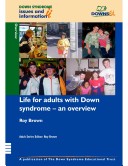Down Syndrome Issues & Information
2 total works
Community and Independent Living for Adults with Down Syndrome
by Roy Brown, Patricia Brown, and Patrick McGinley
Published 5 January 2008
"Summary" - This book discusses community and independent living for adults with Down syndrome. In many ways it follows on and links to a previous book in this series, Families of adults with Down syndrome. It describes the ways adults have moved from family home to community residential living, and in so doing discusses the development of an independent home life integrated with the local community. We have provided examples of people, who vary in their ability levels, along with the successes and challenges they have faced. In some cases, little or no support is required after an initial period of moving home, but we have described the types of resources that are required, and provided some suggestions on how parents can get involved in guiding the process and consulting with professional people in the field. A central point is that the person with Down syndrome must, as far as possible, be placed 'in the driver's seat' and given the types of support to attain their goals. This includes the attainment of skills in home management and community contact. This requires learning and adaptation, but it also involves consultation, discussion and advice.
We indicate how change in situations and development alters the support required, and also discuss the types of social learning that need to take place for success. The need to recognise the huge range of variability amongst people with Down syndrome is stressed, indicating how, with increasing age, new situations arise both for the individual and their family. The challenges and questions that arise in enabling a young adult to continue relating to their family are described,along with the importance of the adult selecting their own choices. There are challenges, not only for individual families in relation to policy and funding issues, but in helping adults to select appropriate places to live. This book provides some suggestions for consideration by parents and professionals. It also looks at the professional training required for frontline personnel, along with the types of behaviours that parents might look for in considering an individual's placement in the community.
One of the challenges in writing this book is that we live at a time when there are adults with Down syndrome still living in institutions who are moving out into the community, while there are young people growing up in their family homes now looking at ways to gain as normal a life as possible in their community. We have attempted to deal with this by providing some history as a background to understanding issues that are now arising, as well as practical means of addressing them.
We indicate how change in situations and development alters the support required, and also discuss the types of social learning that need to take place for success. The need to recognise the huge range of variability amongst people with Down syndrome is stressed, indicating how, with increasing age, new situations arise both for the individual and their family. The challenges and questions that arise in enabling a young adult to continue relating to their family are described,along with the importance of the adult selecting their own choices. There are challenges, not only for individual families in relation to policy and funding issues, but in helping adults to select appropriate places to live. This book provides some suggestions for consideration by parents and professionals. It also looks at the professional training required for frontline personnel, along with the types of behaviours that parents might look for in considering an individual's placement in the community.
One of the challenges in writing this book is that we live at a time when there are adults with Down syndrome still living in institutions who are moving out into the community, while there are young people growing up in their family homes now looking at ways to gain as normal a life as possible in their community. We have attempted to deal with this by providing some history as a background to understanding issues that are now arising, as well as practical means of addressing them.
This book takes a lifespan perspective, and considers how experiences in the past and in the present will impact on choices, opportunities and development in the future. It shows how all aspects of the individual's life are linked together and that changes in one area may have an effect in another. This book is an introduction to the "Down Syndrome Issues and Information Adult Living" series and considers issues affecting people with Down syndrome, aged 17 and above, their families and communities. As an introduction, it sets the scene, through an examination of our values as a society and introduces the reader to a variety of useful approaches, including quality of life, inclusion and exclusion, and rights and discrimination. The book concludes by introducing the specific issues raised in the other books in the series. Although a wide range of needs are addressed and recognition is given to the different circumstances of community living, this overview also recognises that life is not just about assessment and intervention, however important these may be, but is essentially about living life to the full, minimising barriers and maximising opportunities.
References are provided, but detailed journal referencing for specific areas has been largely left to the other writers in the series. The aim of this book is to provide references to books, articles and websites, which should be readily available to parents, associations and practitioners across many disciplines.
References are provided, but detailed journal referencing for specific areas has been largely left to the other writers in the series. The aim of this book is to provide references to books, articles and websites, which should be readily available to parents, associations and practitioners across many disciplines.

